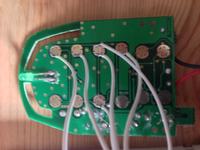deadbird
Newbie level 3
Hi there 
I need some advice: i'm trying to control a remote controller, i'd like an arduino to act as "the user pressing buttons". Is there a way I can use transistor or 4N32-like optocouplers to simulate button press?
Thanks in advance
I need some advice: i'm trying to control a remote controller, i'd like an arduino to act as "the user pressing buttons". Is there a way I can use transistor or 4N32-like optocouplers to simulate button press?
Thanks in advance
